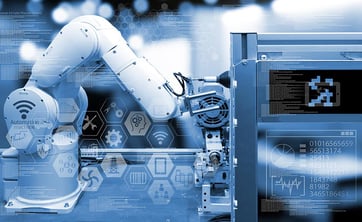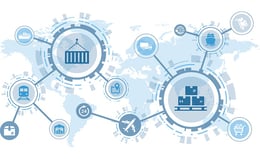Best Ways to Make Your Supply Chain Forecasts Better
Keith LaBotz - July 15, 2021

Weathering Supply Chain Forecasts and Expectations
How does today's forecast look? I predict sunny skies for Logistics 4.0 with scattered disruptions, but nothing close to the COVID storm. Expect forecasting to improve in the long run with the unexpected continuing to challenge supply chains and weather forecasts. The hype over AI and machine learning may promise a glorious future of predictive planning, but Mother Nature taught me a few lessons about this you might want to consider.
One of my hobbies is observing severe thunderstorms. Every spring, I head out to the Great Plains to join researchers and weather enthusiasts to watch the most powerful storms on earth - supercells. Supercells are incredibly beautiful, intense, and exhibit a surreal otherworldly quality. They form rapidly out of the clear blue sky to become towering 10-mile tall monsters that produce nearly every weather phenomenon. They’re relatively short-lived, local storms, and no one knows precisely when and where they will appear, if at all. That’s a big logistics problem, especially if you’ve flown thousands of miles to see one of these superstorms.
My planning begins a week in advance, examining severe thunderstorm forecasts, terrain, and logistics constraints. A list of potential targets narrows with each hourly forecast as we hit the road for a destination that’s often hundreds of miles away. The target destination and route are altered with each forecast, and once storms begin erupting, the environment grows volatile. Forecasting becomes meaningless, and my attention shifts to watching the sky and real-time Doppler weather radar for sudden developments.
Intercepting supercells is a dynamic game of strategy where meteorology meets logistics, and it involves forecasting, planning, routing, monitoring, risk management, transportation optimization, navigation, and changing constraints. The thing is, Mother Nature doesn’t care about forecasts or my expectations, plans, and technology. I either adjust my route or my expectations as conditions change or accept the consequences. Technology has its limits, and predicting the unpredictable is one of them, whether we’re dealing with a supercell or supply chain.
Forecasts Offer No Shelter
Forecasts can be impressively accurate, but they also fail. They’re merely probabilities for a snapshot in time that expire with new conditions, and now we see the problem - our atmosphere and supply chains constantly change without notice. Weather forecasts are notoriously unreliable, and it comes as no surprise that inclement weather remains a leading cause of supply chain disruptions. Even an array of super high-tech systems and sensors on earth and in outer space, plus hundreds of millions of human observers, cannot predict the unpredictable.
Supply chains contend with a challenge far more unpredictable than weather - human behavior. Try explaining why a car would drive slowly in the fast lane for an hour holding back other motorists, or what would cause a container ship captain to try parallel parking in the Suez Canal. Political policy, trends, tariffs, civil strife, labor strikes, lockdowns, mood swings, and hangovers are a fraction of possibilities blowing in the wind. While forecasting provides a general direction for planning, it cannot shelter a supply chain from the storms, and that’s why we are the deciding factor in the supply chain’s success and failure.
Trust Yourself Before Technology
I get real-time updates from weather radar when navigating around supercells, and it’s invaluable for revealing features invisible to the naked eye. It adds another layer of intelligence to my observations, but I don’t depend on technology alone.
revealing features invisible to the naked eye. It adds another layer of intelligence to my observations, but I don’t depend on technology alone.
Technology is a tool; we decide how to use a tool, and sometimes there are better alternatives. I’ve made a habit of cross-checking my visual assessments with radar and forecasts and vice versa. Doing this has improved my judgment and utilization of these tools. It’s also enabled me to continue without interruption when rough weather knocks out the radar. The same applies to supply chain planning and visibility solutions and dashboards providing a Control Tower view of operations.
Keeping our mental acuity honed is essential for utilizing the full potential of technology, and personal judgment can get rusty if we defer to software for all the answers. I’m not advocating looking backward or second-guessing software; instead, understanding business objectives and the processes used should be a top priority. Understanding solutions within this context allows us to see how to make technology serve our purposes more effectively.
Adjust Your Plan
Supercells and supply chains are dynamic, and any plan for them must be too. The unexpected will occur and whatever happens next depends on our response. While a careless moment around a tornadic supercell could result in severe consequences, the logistics of intercepting a supercell is very similar to managing the delivery of a shipment. Encountering an exception goes something like this for both:
- Alter the route to achieve the desired outcome.
- Avoid any changes in the route that increase risk or cost if possible.
- Look for an opportunity to alter the route to reduce costs and improve performance.
It’s a dynamic plan changing en route, and it not only requires real-time visibility but the ability to act on this data. Transportation optimization tools like dynamic routing are essential for supply chains, and they shelter logistics operations from stormy conditions, and I mean that literally.
Adjust Expectations
Expectations are powerful; they shape our perspective, emotions and guide our decisions. My expectations have propelled me year after year to drive thousands of miles to watch storms. Good forecasting technology with a bit of luck helps my plans succeed, but always understanding that the unexpected can undermine my effort. When that happens, I have the option to change my expectations.
Out on the Plains, this might mean calling it a day and pulling off on a deserted country road to listen to songbirds and rumbling distant thunder from the storm that got away. A supply chain may lack the ambiance of nature, but we can still shift expectations and even positively impact our customers at the same time. For example, notifying a customer when a shipment will not arrive on time can create an inclusive experience that allows them to change their expectations.
Connect the Dots to Understand Forecasts
While forecasting plays a vital role in supply chain efficiency, successful logistics is ultimately about partnering with stakeholders to meet their expectations. When things don’t go according to the forecast, we need to let the bigger picture guide us to support each parties’ interests. Technology is a tool, and our perspective largely determines how we utilize it, affecting the outcome.
We are the bridge between technology and customer experience, and that requires us to connect the dots between our roles, objectives, systems, and the customer. Technology correctly implemented aligns these elements in a process that reflects a bigger picture. Understanding it makes the unexpected easier to deal with; adjusting plans or expectations becomes quicker and simpler.
Expectations Are More Important Than Forecasts
Forecasts are a valuable guide until the unexpected enters the picture, and then, it comes down to our grasp of expectations and how we can meet them. Understanding this requires us to connect the dots in a supply chain, whether managing the delivery of a shipment or drafting digitalization plans for Logistics 4.0 or sustainability initiatives. My forecast says we’ll be talking more about these issues in future posts, and hopefully, that will meet your expectations.
For more information, download our guide by clicking on the image below.
LATEST POSTS
- Understand Circular Economy in The Manufacturing Industry
- How Can Industry 4.0 IT Integration Be Achieved Smoothly?
- The Significance of Order Sequencing in Discrete Manufacturing
- How to improve your Supply Chain Management: The Power of Control Towers
- Optimizing Human Resource Scheduling in Manufacturing: A Technological Approach



